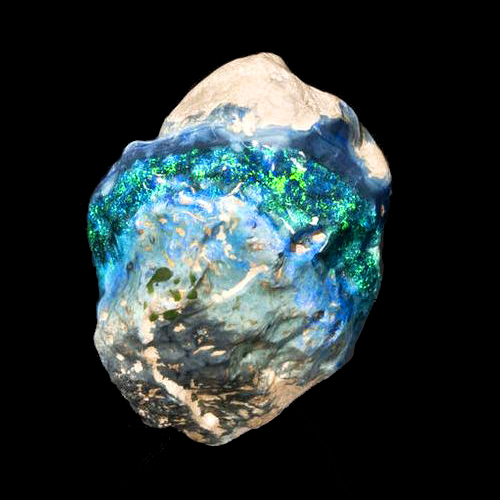Since the 1840s, resilient individuals in Australia's outback have tirelessly excavated its unforgiving terrain in search of the elusive opal. A fortunate few struck gold, unearthing remarkable opals that have since become legendary in Opal folklore and celebrated worldwide.

As seasoned opal buyers, We possessed a remarkable ability to assess rough opals and discern the quality of the gem hidden beneath their sandstone crusts.

Discovered in 1938 at Lightning Ridge, New South Wales, the Aurora Australis is reputed to be the world's most valuable black opal. Unearthed from an ancient seabed by opal miner Charlie Dunstan, it bears a distinctive starfish-like impression on its surface. This opal exhibits a harlequin pattern with vibrant red, green, and blue colors set against a black background. Weighing 180 carats and measuring 3 inches by 1.8 inches, its rarity stems from its size and intense color play.

Discovered in 1915 at Phone Line by Urwin and Brown under the name 'Harlequin Prince', the Black Prince is considered the least notable among four significant stones from the same claim. Weighing 181 carats, it featured a flag pattern on one side and red hues on the other.
This black opal was purchased in England by a wealthy American serviceman and subsequently gifted to the New York Museum of Natural History. Later, it became part of the collection at Forest Lawn Memorial Cemetery in Los Angeles.

Discovered during World War I at the 'Phone Line' field, the Butterfly Stone or Red Admiral weighs approximately 51 carats and is renowned for its exceptional beauty. Its predominant red pattern is visible from every angle. It was named "Butterfly" in 1920 due to its resemblance to the Red Admiral, a British butterfly.

Discovered in 1906 by Charlie Dunstan at the Angledool Diggings, Lightning Ridge, the Fire Queen weighed about 900 carats. Initially sold by Dunstan for 100 pounds, the opal changed ownership several times. By 1928, it was held in the Chicago Museum and valued at £40,000. In the 1940s, J.D. Rockefeller acquired the Fire Queen for £75,000, adding it to his esteemed family gem collection.

Also known as the "Red Emperor," the Pride of Australia was discovered in 1915 by Tom Urwin and Snowy Brown at Phone Line, Lightning Ridge. Weighing 225 carats when cut, this opal measured 2" x 3" and showcased black and blue veins intertwined with vibrant red streaks. By 1954, it had been exhibited at least five World Fairs as Australia's premier opal. Ernie Sherman purchased the Pride of Australia along with three other stones from the miners for £2000 around 1920, marking the highest price ever paid for four black opals.
In the 1950s, the Pride of Australia was sold to Dr. Hubert Eaton, President and Founder of Forest Lawn Memorial Park in Glendale, CA, USA, for a reputed £150,000.

Halley's Comet is recognized in the Guinness Book of Records as the largest uncut black opal nobby in the world. Discovered by a group of opal miners from the Lunatic Hill Syndicate on the Leaning Tree Claim at Lightning Ridge around the time of Halley's Comet's appearance in Australian skies, it weighs 1982.5 carats and measures 100 x 66 x 63 mm. In 2005, Halley's Comet was listed for sale for AUD$1.2 million.

Regarded as one of the world's most exquisite opals, The Virgin Rainbow is a 63.3mm Black Crystal Opal Belemnite Fossil in a pipe shape. It features gem-quality colors and is reputed to glow in the dark. Discovered by John Dunstan at Three Mile Fields, Coober Pedy, South Australia, in September 2003, The Virgin Rainbow weighs 72.65 carats.